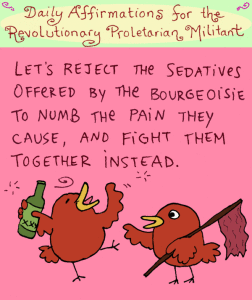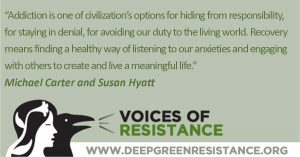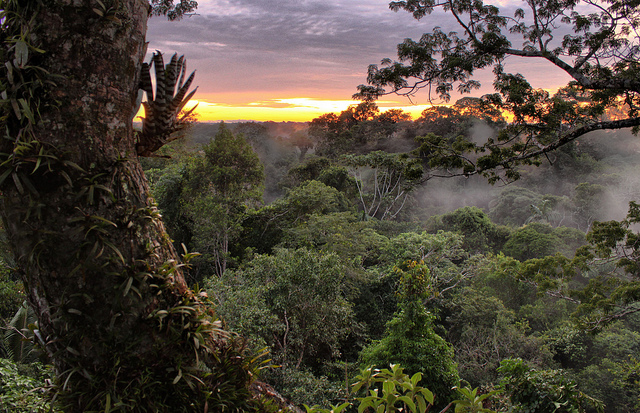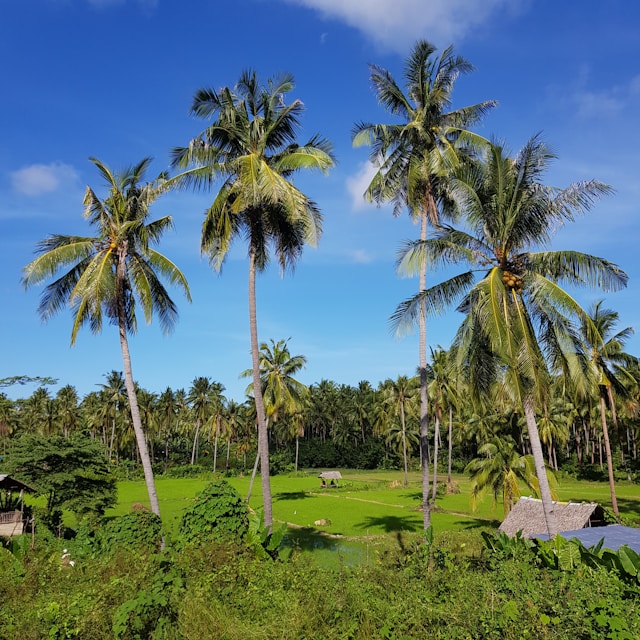Restoring Sanity, Part 3: Medicating – Susan Hyatt & Michael Carter
By Susan Hyatt and Michael Carter, DGR Southwest Coalition
This article is the third part of a series on mental health. You can read the first piece: “An Inhuman System” and the second: “Mental Illness as a Social Construct”.
What was my drink
My delicious addiction
That led to my oppression?
My drug of choice
I held in my hand
Was a glassful of depression.
—Carol Ann F., Vashon Island, Washington
If you watched any commercial television in the early 1990s, you may remember the Old Milwaukee beer ad featuring pleased men relaxing with a couple sixpacks, agreeing that “It doesn’t get any better than this.” Advertising has a way of being more effective the more farfetched it becomes, by way of memorable slogans and images rather than accuracy. Anyone who has tasted Old Milwaukee can assure you it does get better than this. But any dubious, subjective claim might still sell something, so long as buyers can at least pretend to believe it. Capitalism needs to make—at the very least—a hypothetical promise of fulfillment and anything so hard to come by is an easy sale, especially when it’s cheap and one is poor.
Because civilization requires class divisions to create a labor pool to do menial and dangerous work, so long as it exists there will always be those whose only contentment will come from some product or other. Television, alcohol, drugs, refined sugar, and gambling might head a list of such surrogates. If we see civilization as a vicious pyramid scheme and not the advanced condition of society that it claims to be, the role of chemical and media distractions in our lives becomes clear. If life doesn’t get any better than Old Milwaukee beer, then that is what we’ll buy. If eating is the closest thing to love we feel, then eat we will. And someone always wins the lottery, after all.
For many, substances and entertainment become not an augmentation to a satisfying life, but a substitute, and the effects vary widely from person to person and group to group. Alcohol has a much more devastating effect on those with little metabolic ability to process it, for example, and it’s an insidious process. The onetime casual drinker might find herself absorbed by a daily ten drinks. The occasional betting man may come to see his savings, house, and family vanish into a casino. Diversion often becomes addiction; self-medication transforms into crisis.
Clinical psychologist Janina Fisher summarizes this progression: “The first assumption is that any addictive behavior begins as a survival strategy: as a way to numb, wall off intrusive memories, self-soothe, increase hypervigilance, combat depression, or facilitate dissociating. The addiction results from the fact that these psychoactive substances require continual increases in dosage to maintain the same self-medicating effect and eventually are needed just to ward off physical and emotional withdrawal.” [1]
In our last essay [2] we reviewed the options available to the one in four US adults who suffer from a “diagnosable mental disorder,”[3] options that increasingly are dominated by psychiatric medications. While these popular drugs may be useful as a short-term remedy to severe problems, behavior and talk therapy appears to be more durable and less risky. [4] Yet given a choice between months or years of hard, introspective work and a pill that takes a second to swallow, it isn’t surprising that many take the shortcut. One out of three doctor’s office visits by women, for instance, include prescription of an antidepressant drug. [5]
Antidepressants and antipsychotics sales multiplied almost fifty times from 1985 to 2008, to $24.2 billion. [6] Sales of prescription antidepressants declined from $11.6 billion in 2010 to $11 billion in 2011; [7] by comparison, liquor sales hit $19.9 billion in 2011, up 4 percent from 2010. [8] And this is only in the US, where seventy-nine thousand deaths are blamed on alcohol annually and alcoholism is the third highest lifestyle-related cause of death. About 40 percent of US hospital beds not devoted to maternity and intensive care are occupied by someone with an alcohol-related illness. [9] Americans spend a lot of money on booze and its aftereffects.
Because most alcoholics will insist there is no problem—or at least no alcohol problem—it’s impossible to say whether a bottle of vodka is for harmless leisure or desperate treatment of a harrowing emotional emergency. Alcoholism is hard to define, and no one even clearly understands how alcohol works on the human body. Any addiction is hard to define. It could simply be something you can’t stop. The American Heritage Dictionary calls it “the condition of being habitually or compulsively occupied with or involved in something,” a “compulsive physiological or psychological need for a habit-forming substance.”
Most humans have a desire to feel good, to minimize pain and effort and maximize ease and pleasure. We also seem to enjoy repeated experiences; watch someone at a slot machine sometime, mechanically feeding coin after coin, eerily rapt. Who doesn’t want a sense of meaning and substance to their days, a feeling of profundity, or simply relief from worry and regret? These can be achieved through discipline, surrender of controlling behaviors and cultivation of new behaviors—all without damaging your body and mind—but you can also find a toxic mimic of peace of mind by medicating yourself with chemicals or passive, fabricated experiences. The latter options have a grim list of negative consequences, from liver cirrhosis to obesity to insanity, all of which distance the user from authenticity, adventure, and self-respect. Pornography and alcohol aren’t known for aiding good romantic relationships, and an oxycontin monkey on your back will not steer you to happiness. Yet the prevalence of addictive behavior and the damage it causes shows that many try anyway.
The Problem with Alcohol
Our own experience with chemicals varies widely, as it does with anyone: To pick alcohol as maybe the most common of civilization’s intoxicants, Hyatt has been good and drunk—staggering, vomiting—only twice in her life. Carter, on the other hand, never met a drink he couldn’t live with, or a cigarette he didn’t like. In his prime he could put away a six-pack of strong beer and a bottle of wine a night with only a faint headache the next day. Certainly by some definitions this is alcoholism. Though he hasn’t smoked for seven years or drank any alcohol for a year and a half, they remain for him substances with a lingering, obsessive attraction, a rueful glamorous draw. He can’t watch someone have a smoke without a mix of disgust and ragged envy. It doesn’t last long and it’s only a tiny struggle to get past the feelings, but they are there.
The problem with alcohol, an experienced therapist tells us, is that we put it in our mouths. Just like the problem with oil and coal is that we burn it. Until we engage with it, it just sits there, benign and innocuous; when we do engage it, it becomes a relationship. We don’t ordinarily think of interactions with chemicals to be relationships, so it’s hard to imagine “abusing” them. Do drug abusers punch their needles, yell at their pills? When people intentionally cut themselves, they’re not abusing the knife.
It’s more a question of how we choose to treat ourselves. Consider a bad relationship you’ve been in. Remember the pattern of alternating moments of clinging and rejection, bliss and sour regret, warm contentment and self-loathing, sure belonging and desolate unworthiness. Once a relationship becomes abusive, it doesn’t stop being abusive, it only lingers and escalates, doing more damage. Power is being exerted in a bewilderingly damaging way.
Addiction may be the advanced condition of a toxic relationship, and the only way life improves then is to end the relationship. Any reforming alcoholic can tell you the attraction of living without alcohol isn’t in the absence of booze, the void where the relationship was; it’s in the promise of vitality, surprise, and freedom from intoxicated depression in new relationships.
The Anatomy of Avoidance
Our way of life, which we did not choose, requires most of us to spend most of our waking time at jobs that make us unhappy.[10] Our sense of optimism and interest in life erodes when what we want to do is usually subordinate to what we have to do. This is the baseline of civilized existence, the background circumstances. The amount of time spent at work is something humans haven’t evolved with—instead it is a condition that spread by conquest, like agriculture and industry. We are still creatures of the Paleolithic, leading lives based on entrapment by a contrived economy.
Add some everyday stressors: appointments, family conflicts, arguments with partners, fear of violence, illnesses, even small annoyances. If work weren’t a necessity—the bind nearly all civilized people are in—these stressors wouldn’t amount to much more than everyday matters easily resolved. If staying home and tending to a child’s illness didn’t get you fired, it wouldn’t be that big a deal. In healthy, intact indigenous cultures, light-heartedness is the normal condition. [11] In civilization, it’s a rarity, the most ephemeral enjoyment. It’s no wonder we avoid every hard task we can. Paradoxically, work itself is a highly acceptable method of avoidance, though a hard-driven capitalist can do more damage than a homeless crack addict could ever dream of.
This isn’t avoidance in the sense of swerving to avoid a car crash; instead, it’s a pattern of learned behavior, a way of responding to negative feelings. It’s our responses, rather than the negative feelings themselves, that determine our emotional condition. Emotional learning takes place whether perceived threats actually exist or not. [12] If you avoid bathing for fear of sharks in the tub, even if you know full well how irrational the fear is you still condition yourself to a response—you’re rewarded by the alleviation of your discomfort by not doing what it is you fear. But of course some problems remain, and grow.
Procrastination is a classic example of avoidance behavior that breeds anxiety because the thing we’re putting off continues to plague and unsettle. The perceived discomfort of resolution continues to escalate out of proportion to reality. How big a deal is it to wash the dishes? An extremely big deal, eventually. Pile on some more serious tasks like resolving an argument or a medical issue, and you have a mess easily soothed by booze, a pill, a casual hook-up (who hopefully doesn’t mind a reeking sinkful of dishes). These temporary fixes don’t resolve the problems, however. When they are habit forming and have their own destructive consequences, they become additional problems, also easy to mediate by simply continuing them. Problem drinkers know well that nothing fixes a hangover like the hair of the dog.
Avoidance becomes a part of your personality, and a way of life. It becomes more oppressive than all you’re avoiding; it demands your energy and attention, until you can feel it pressing in on you from outside, worrying itself from the inside. It nags and cajoles, urges quick solutions, makes self-serving promises. It is the parent of indifference, the older sibling to addiction. Apathy and numbing are defenses against the overwhelming anxiety formed by avoidance. For anyone working for social and environmental justice, where trauma and loss are everyday realities, avoidance can be very attractive, but eventually disastrous. How can anyone live fully in (let alone protect) the world if they are stuck in habits that lead to disconnection and withdrawal from the world?
Treatment Options
By the time an alcohol or drug problem becomes serious enough that it can’t be ignored, when a DUI or organ failure or intervention by others has forced it out of the protection racket of avoidance, the sufferer’s life is likely so compromised by damaged relationships and financial problems that finding the resources to deal with it can be extremely difficult. Until the advent of Alcoholics Anonymous in 1935, there was no very effective means of treating alcoholism. AA and its spinoffs—Narcotics Anonymous, Gamblers Anonymous, and others organized around the Twelve Steps principles of recovery—don’t offer a huge statistical hope of success, but they do offer some, [13] and are far better than the snake pit asylums that used to await chronic alcoholics.
Twelve Step groups and the spiritual, community-oriented recovery plan they use are controversial. The language of the Steps [14] sounds suspiciously Christian in tone, though in practice it’s entirely secular; no particular religious group sponsors AA. The organization holds that alcoholism is a disease, a view that’s strenuously objected to by other recovery approaches. [15] The multiple methods now available are good news for addicts, who’d be well advised to be open to anything that might work. Scrutinizing the life preserver when you’ve gone down for the proverbial third time is as good a description of the insanity of addiction as any.
This doesn’t mean that any one thing or another will work, of course. AA members, well aware of how their message is often doubted, like to say “take what you need and leave the rest.” One therapist we talked with, skeptical of AA, nevertheless remarked that disliking AA is one of the best reasons to go to their meetings, because it makes you think about—and hopefully begin to understand—the nature of your problems. In this small space, we can offer only a quick analysis of Twelve Step programs; we think they’re well worth looking into for their widespread presence, emphasis on engagement with others, and group problem-solving. And they’re free.
There are no other settings we’re aware of where one can be well-understood, respectfully listened to, and given zero slack for rationalizing bullshit. Alcoholics tend to believe they’re some sort of tragically, perhaps terminally unique actors on a sadist’s stage, shat upon daily by an unjust god. Hearing the same experiences of others on a routine basis (newcomers to AA are encouraged to attend ninety meetings in ninety days) dissolves this addiction-serving worldview, and builds a sense of community and common interest with others where once only egocentrism and false pride stood.
Any member of the dominant culture could well use just such a transformation. Only the incremental deposing of assumed godlike power will rescue the biosphere from civilization. The experiences of wretched addicts, who have managed to surrender control, are relevant to all who wish to understand how this mechanism might work. Addiction is one of civilization’s options for hiding from responsibility, for staying in denial, for avoiding our duty to the living world. Recovery means finding a healthy way of listening to our anxieties and engaging with others to create and live a meaningful life.
Bibliography and Further Reading
- Alcoholics Anonymous World Services. Alcoholics Anonymous. New York: AA World Services, 2001.
- ________. Twelve Steps and Twelve Traditions. New York: AA World Services, 1994.
- Evans, Patricia. The Verbally Abusive Relationship: How to Recognize It and How to Respond. Avon, MA: Adams Media, 2010.
- Friends in Recovery. Edited by Kathleen W. 12 Steps to Freedom: A Recovery Workbook. Freedom, CA: The Crossing Press, 1991.
- Fuller, Alexander. “In the Shadow of Wounded Knee,” National Geographic, August 2012, 51.
- Glendinning, Chellis. My Name is Chellis and I’m in Recovery from Western Civilization. Boston: Shambhala Publications, 1994.
- Leventhal, Allan M. and Martell, Christopher R. The Myth of Depression as Disease: Limitations and Alternatives to Drug Treatment. Westport, CT: Praeger Publishers, 2006.
- Peele, Stanton. Diseasing of America: Addiction Treatment out of Control.Lexington, MA: Lexington Books, 1989
- Trimpey, Jack. Rational Recovery. New York: Pocket Books, 1996.
- Villar, Oliver and Cottle, Drew. Cocaine, Death Squads, and the War on Terror: U.S. Imperialism and Class Struggle in Colombia. New York: Monthly Review Press, 2011.
Online
- Rohith Sebastian, “A New Approach to Overcoming Psychological Disorders,” Psych Central, accessed May 7, 2014,http://psychcentral.com/blog/archives/2014/04/10/a-new-approach-to-overcoming-psychological-disorders/
- Kyung Jin Lee, “Capitalism Makes Us Crazy: Dr. Gabor Maté on Illness and Addiction,” TruthOut, June 1, 2013, http://www.truth-out.org/news/item/16711-capitalism-makes-us-crazy-dr-gabor-mate-on-illness-and-addiction
- Jamie Doward, “Medicine’s big new battleground: does mental illness really exist?” The Observer, May 11, 2013,http://www.theguardian.com/society/2013/may/12/medicine-dsm5-row-does-mental-illness-exist
- Corrinne Burns, “Are mental illnesses such as PMS and depression culturally determined?” The Guardian, May 20, 2013,http://www.theguardian.com/science/blog/2013/may/20/mental-illnesses-depression-pms-culturally-determined
- Medical University of Vienna, “Depression detectable in the blood: Platelet serotonin transporter function,” ScienceDaily, April 29, 2014,www.sciencedaily.com/releases/2014/04/140429105015.htm
- Matthew Miller, MD, ScD1; Sonja A. Swanson, ScM2; Deborah Azrael, PhD1; Virginia Pate, PhD, PhD3; Til Stürmer, MD, ScD3, “Antidepressant Dose, Age, and the Risk of Deliberate Self-harm,” JAMA Intern Med., April 28, 2014,http://archinte.jamanetwork.com/article.aspx?articleid=1863925
Endnotes
[1] Janina Fisher, Ph.D., “Addictions and Trauma Recovery,” Paper presented at the International Society for the Study of Dissociation, November 13, 2000,http://www.janinafisher.com/pdfs/addictions.pdf
[2] Susan Hyatt and Michael Carter, “Restoring Sanity, Part 2: Mental Illness as a Social Construct,” Deep Green Resistance Southwest Coalition, March 13, 2014, http://deepgreenresistancesouthwest.org/2014/03/13/restoring-sanity-part-2-mental-illness-as-a-social-construct/
[3] Kessler RC, Chiu WT, Demler O, Walters EE, “Prevalence, severity, and comorbidity of twelve-month DSM-IV disorders in the National Comorbidity Survey Replication (NCS-R),” Archives of General Psychiatry, 2005 Jun;62(6):617-27.
[4] “Studies have shown that behavior therapy provides remedies that are longer-lasting and pose no concerns regarding side effects.” Leventhal and Martell, p. 137.
“A growing number of overdoses of legal opioids, sedatives and tranquilizers led to a 65 percent increase in hospitalizations over seven years,” Katherine Harmon, “Prescription Drug Deaths Increase Dramatically,” Scientific American, April 6, 2010,http://www.scientificamerican.com/article/prescription-drug-deaths/ While not about psychiatric drugs in particular, this article does underscore the hazard in so many medications simply being at large, available for addictive use or accidental overdose and death.
[5] Leventhal and Martell, p. 135.
“Researchers say women are more likely to have depression and anxiety, while more men report substance abuse,” James Ball, “Women 40% more likely than men to develop mental illness, study finds,” The Guardian, 22 May 2013,http://www.theguardian.com/society/2013/may/22/women-men-mental-illness-study
[6] John Horgan, “Are Psychiatric Medications Making Us Sicker?” Scientific American, March 5, 2012, http://blogs.scientificamerican.com/cross-check/2012/03/05/are-psychiatric-medications-making-us-sicker/
“Writing a prescription to treat a mental health disorder is easy, but it may not always be the safest or most effective route for patients, according to some recent studies and a growing chorus of voices concerned about the rapid rise in the prescription of psychotropic drugs,” Brendan L. Smith, “Inappropriate prescribing,” June 2012 Monitor on Psychology, June 2012, Vol 43, No. 6, print version: page 36, https://www.apa.org/monitor/2012/06/prescribing.aspx
[7] Craig W. Lindsley, “The Top Prescription Drugs of 2011 in the United States: Antipsychotics and Antidepressants Once Again Lead CNS Therapeutics,” ACS Chem. Neurosci., 2012, 3 (8), pp 630–631, August 15, 2012,http://pubs.acs.org/doi/full/10.1021/cn3000923 The ACS is the American Chemical Society. The figures for drug sales are located on Table 2.
[8] Brad Tuttle, “Cheers! Increase in Liquor Sales Bodes Well for Economic Recovery,” Time, January 31, 2012,http://business.time.com/2012/01/31/cheers-increase-in-liquor-sales-bodes-well-for-economic-recovery/
[9]“Facts about Alcohol,” National Council on Alcoholism and Drug Dependence, accessed February 10, 2011.
[10] “According to the Gallup 2013 State of the American Workplace report, 52 percent of American full-time workers said they were ‘disengaged’ at work, meaning that they put time and effort into their work, but didn’t have energy or passion for it. Together, 70 percent of employees said they were either ‘disengaged’ or ‘actively disengaged,’ the latter term defining workers who openly express their discontent and undermine the efforts of their engaged colleagues. Just 30 percent of the workers polled said they felt ‘engaged’ at work, meaning they are ‘involved in, enthusiastic about, and committed to their work and contribute to their organization in a positive manner.’” Eli Epstein, “How many Americans are unhappy at work?” MSN News, June 25, 2013,http://news.msn.com/us/how-many-americans-are-unhappy-at-work
[11] “In one study, researchers used a storytelling technique to evaluate three groups of Kenyan women: rural women in a traditional village, poor urban women, and middle-class urban women…traditional women almost always told very positive stories that usually had a happy ending. Middle-class urban women told stories that emphasized their own power and competence. Poor urban women’s stories were generally tragic and focused on powerlessness and vulnerability. The researchers note that many poor urban women have ‘lost the security and protection of the old [traditional] system without gaining the power or rewards of the new system,’” Friedman, Ariellad and Todd, Judith. “Kenyan Women Tell a Story: Interpersonal Power of Women in Three Subcultures in Kenya.” Sex Roles 31: 533-546, in Nanda, Serena and Warms, Richard L.Cultural Anthropology. Belmont, CA: Wadsworth/Thomson, 2004, 387, 388.
[12] Leventhal and Martell, p. 82.
[13] “Accurate reports about the success rates of 12-step programs like AA and NA are notoriously difficult to obtain. The few studies that have attempted to measure the effectiveness of the program have often been contradictory. Fiercely protective of their anonymity, AA forbids researchers from conducting clinical studies of its millions of members. But the organization does conduct its own random surveys every three years. The result of AA’s most recent study in 2007 were promising. According to AA, 33 percent of the 8,000 North American members it surveyed had remained sober for over 10 years. Twelve percent were sober for 5 to 10 years; 24 percent were sober 1 to 5 years; and 31 percent were sober for less than a year,” Kevin Gray, “Does AA Really Work? A Round-Up of Recent Studies,” The Fix, January 29, 2012,http://www.thefix.com/content/the-real-statistics-of-aa7301
[14] “The Twelve Steps of Alcoholics Anonymous: 1. We admitted we were powerless over alcohol—that our lives had become unmanageable. 2. Came to believe that a Power greater than ourselves could restore us to sanity. 3. Made a decision to turn our will and our lives over to the care of God as we understood Him. 4. Made a searching and fearless moral inventory of ourselves. 5. Admitted to God, to ourselves, and to another human being the exact nature of our wrongs. 6. Were entirely ready to have God remove all these defects of character. 7. Humbly asked Him to remove our shortcomings. 8. Made a list of all persons we had harmed, and became willing to make amends to them all. 9. Made direct amends to such people wherever possible, except when to do so would injure them or others. 10. Continued to take personal inventory and when we were wrong promptly admitted it. 11. Sought through prayer and meditation to improve our conscious contact with God, as we understood Him, praying only for knowledge of His will for us and the power to carry that out. 12. Having had a spiritual awakening as the result of these Steps, we tried to carry this message to alcoholics, and to practice these principles in all our affairs.” A.A. World Services, Inc., May 9, 2002, www.aa.org/en_pdfs/smf-121_en.pdf
[15] “Peer-reviewed studies peg the success rate of AA somewhere between 5 and 10 percent. That is, about one of every fifteen people who enter these programs is able to become and stay sober. In 2006, one of the most prestigious scientific research organizations in the world, the Cochrane Collaboration, conducted a review of the many studies conducted between 1966 and 2005 and reached a stunning conclusion: ‘No experimental studies unequivocally demonstrated the effectiveness of AA’ in treating alcoholism. This group reached the same conclusion about professional AA-oriented treatment (12-step facilitation therapy, or TSF), which is the core of virtually every alcoholism-rehabilitation program in the country,” Lance Dodes and Zachary Dodes, “Sober Truth: Debunking the Bad Science Behind 12-Step Programs and the Rehab Industry,” excerpt in “AA and Rehab Culture Have Shockingly Low Success Rates,” AlterNet, April 2, 2014, http://www.alternet.org/books/pseudoscience-aa-and-rehab?paging=off¤t_page=1#bookmark
Peele, 1989.
Trimpey, 1996.
Susan Hyatt has worked as a project manager at a hazardous waste incinerator, owned a landscaping company focused on native Sonoran Desert plants, and is now a volunteer activist. Michael Carter is a freelance carpenter, writer, and activist. His anti-civilization memoir Kingfisher’s Song was published in 2012. They both volunteer for Deep Green Resistance Southwest Coalition.
From DGR Southwest Coalition: “Restoring Sanity Part 3: Medicating”





